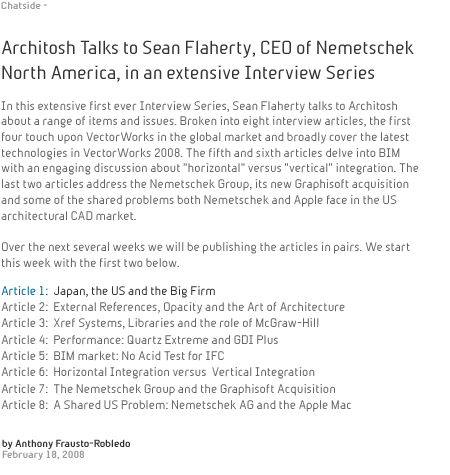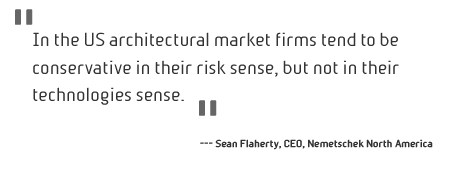|

Back
in the fall of last year I got on the phone with Sean
Flaherty, CEO, of Nemetschek
North America, to discuss
his company's recent new release, VectorWorks 2008.
What was expected to be 30 minutes turned into more
than an hour of intense discussion about not just the
newest version of the venerable VectorWorks CAD/BIM
software, but a broad discussion about the nature of
BIM itself, the opportunities for integration at the
software level (both horizontal and vertical), and
his parent company's (Nemetschek of Germany) decision
to acquire
rival Graphisoft, makers of ArchiCAD.
In
this series of interview articles Mr. Flaherty answers
questions that have been on the minds of analysts and
end-users alike. What will happen to both VectorWorks
and ArchiCAD long-term? Why did Nemetschek AG buy Graphisoft
to begin with? Why doesn't Nemetschek of Germany have
a stronger reputation in the United States? Will VectorWorks
ever hold the reputation of being a true BIM?
These
are just some of the many facets of this interview
series, along with a topical coverage of what makes
VectorWorks 2008 such a strong product, what makes
it unique, and what the product holds for users in
the future. This first segment gets us started with
some global perspective.
Japan,
the US and the Big Firm
AFR: How did you come up with the name of VectorWorks 2008?
Does this have anything to do with how Nemetschek AG
named the new Allplan 2008?
Sean
Flaherty, CEO (SF):
We wanted something very physical to indicate the change
we are making with this version. We have been on roughly
nine month [development] cycles up until now, with every
other release being the first digit chargeable upgrade.
[Now we are moving to an annual development cycle.]
The
engineering team is breathing a big sigh of relief that
we are going to a longer product cycle. From a marketing
stand point I guess we are shortening the cycle but from
an R&D standpoint that was one of the big drivers
here—to get the team timed to handle some of the
bigger functional requests.
What's
the difference between big
and small in
terms of the cycle?
(SF):
I think we have been putting in a lot of important
efficiency gains into the product and a lot of
these tend to luckily be small programming projects.
What we are seeing ahead of us now is a growing
pile of fairly big things that we need to do and
so this will give us a little more time for that.
Secondly,
we are steadily moving into the larger and larger
offices of 30 plus people, where you tend to have
an IT Manager that is in charge of not only the
CAD applications but budgeting. We hear a lot that
they wished they knew how much it was going to
cost every year so that they could get it on the
budget and get the technology when they need it.
We find that the annual cycle matches well with
how large companies do their spending. It has nothing
to do with the avoiding the number 13. Not that
13 is a bad number. [Laughs…]

Your
comment about larger offices is interesting. If
I understand you correctly one of the key things
about this is that you are now talking more to
the IT Manager and this involves the
strategic costs of implementing VectorWorks long
term.
(SF):
Yes. What is interesting about this is that it is a very
different type of marketing and when we talk to
sole practitioners and small firms you are usually speaking
to an architect. We
are finding with the larger customers they
are weighing a lot
of other factors in addition to CAD.
We
just want to make sure we are in a good position.
The
small
offices
are still a big priority for us but in
order to continue our growth we need to make sure
there is a configuration for everybody and we need
to consider the needs of the larger offices. That
is particularly the case in the US where we tend
to have a strong hold among smaller firms. Internationally,
we tend to have a bigger share of the 30-100
person firms.
Why
do you think that is?
(SF):
The US is one of the few countries that Autodesk
has a strangle hold on the market. But it is not
so in Europe, Japan and Asia. And they are important
players to us because of their sheer size.
But
what about cultural differences?
(SF): That too. In the US architectural market firms tend to
be conservative in their risk sense, but not in
their technologies sense.
Explain...
(SF):
They
tend to adopt things more quickly than in
a lot of other countries as far as integrating
new technologies go, but from a risk
sense we have a lot of trouble having them look
at us.
They
seem to want a big brand.
Our biggest
problem is not
convincing them that VectorWorks
is a good product but getting them to stop for
a second
and
let
us start our convincing. We have a
very good close rate once we get people to stop
and
look
at our
company.
And
you don't have that problem outside the US....
(SF):
It is interesting when I go to Japan we have 3000
person offices using
VectorWorks...hundreds and hundreds of persons
all using
VectorWorks. We are looking at what we
can do in
the US
to
match this.
Is
it also about the type of work that the architectural
professionals are working on?
In Japan they have manufactured housing, things
like that.
(SF):
I think the residential architectural market is
a much bigger industry here in the US just because
home ownership in the US is much higher. I probably
shouldn't say it without the stats to back
it up but it is just my perception.
articles:
| 1 | 2 | 3 | 4 | 5 | 6 | 7 | 8 |
Reader Feedback: Talk to us:
|






![]()
![]()